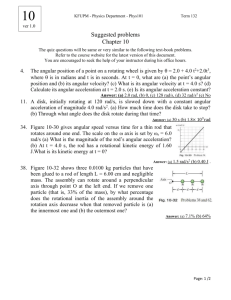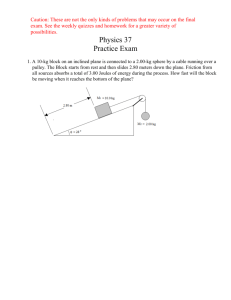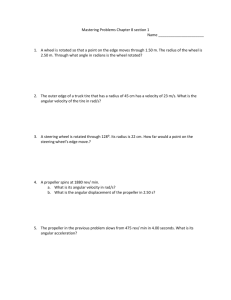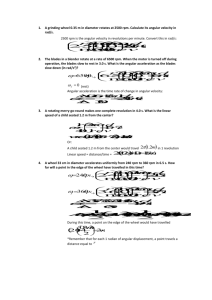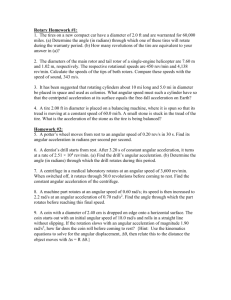Rotary Motion
advertisement
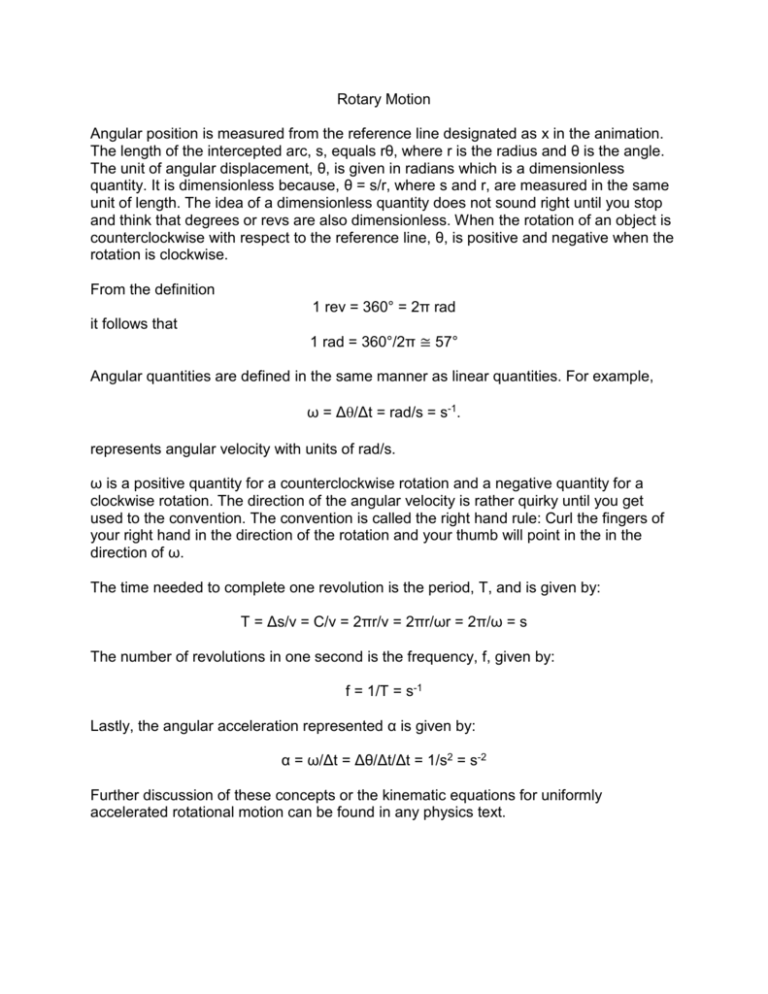
Rotary Motion Angular position is measured from the reference line designated as x in the animation. The length of the intercepted arc, s, equals rθ, where r is the radius and θ is the angle. The unit of angular displacement, θ, is given in radians which is a dimensionless quantity. It is dimensionless because, θ = s/r, where s and r, are measured in the same unit of length. The idea of a dimensionless quantity does not sound right until you stop and think that degrees or revs are also dimensionless. When the rotation of an object is counterclockwise with respect to the reference line, θ, is positive and negative when the rotation is clockwise. From the definition 1 rev = 360° = 2π rad it follows that 1 rad = 360°/2π ≅ 57° Angular quantities are defined in the same manner as linear quantities. For example, ω = Δ/Δt = rad/s = s-1. represents angular velocity with units of rad/s. ω is a positive quantity for a counterclockwise rotation and a negative quantity for a clockwise rotation. The direction of the angular velocity is rather quirky until you get used to the convention. The convention is called the right hand rule: Curl the fingers of your right hand in the direction of the rotation and your thumb will point in the in the direction of ω. The time needed to complete one revolution is the period, T, and is given by: T = Δs/v = C/v = 2πr/v = 2πr/ωr = 2π/ω = s The number of revolutions in one second is the frequency, f, given by: f = 1/T = s-1 Lastly, the angular acceleration represented α is given by: α = ω/Δt = Δθ/Δt/Δt = 1/s2 = s-2 Further discussion of these concepts or the kinematic equations for uniformly accelerated rotational motion can be found in any physics text. Rotary Motion Problems 1) A bicycle wheel accelerates uniformly from rest to an angular velocity of 18 revs/m in 5.0 s. What is its angular acceleration? ωi = 0 ωf = 18 rev/min Δt = 5.0 s ωf = ωi + αΔt => α = (ωf - ωi)/Δt α = 18 rev/min*2π/rev*1 min/60 s/5.0 s = 0.38 rad/s2 2) Determine the angular velocity, in rad/s, of the earth as it rotates on its axis. ω = 1 rev/day*1 day/24 h*1 h/3600 s*2πrad/1 rev ≈ 7.27 x 10-5 rad/s 3) A car traveling 40.0 m/s has wheels that are 0.850 m in diameter. Determine the: (a) angular speed of the wheels vi = 40.0 m/s d = 0.850 m v = ωr ω = v/r = 40.0 m/s/0.425 m/ = 94.1 rad/s (b) angular acceleration if the car stops in 12.0 s. Assume the acceleration to be constant. ωf = ωi + αΔt α = 0 - 94.1 rad/s/12.0 s = -7.84 rad/s2 (c) number of revolutions of the wheels in 12.0 s. Δθ = ωiΔt + 1/2αΔt2 Δθ = 94.1 rad/s*12.0 s +1/2*-7.84 rad/s2*(12.0 s)2 = 565 rad Δθ = 565 rad*1 rev/2πrad = 90.0 rev 4) Determine the angular velocity in radians for the: (a) second hand of a watch ω = 1 rev/60 s*2π/rev = 0.105 rad/s (b) minute hand of a watch ω = 1 rev/60 min*2π/rev•1 min/60 s = 0.105 rad/s (c) hour hand of a watch ω = 1 rev/12 h*2π/rev*1 h/3600 s = 1.45 x 10-4 rad/s




